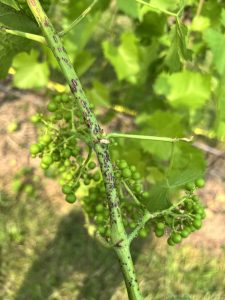Grape Anthracnose this Rainy Season
With the frequency of rain we’ve experienced this season, grape anthracnose is emerging in several vineyards. This increase in moisture creates ideal conditions for the pathogen to thrive, leading to more widespread infection compared to previous seasons. Anthracnose is especially destructive during warm, wet seasons, and can infect all green parts of the vine—leaves, shoots, stems, tendrils, and fruit. The most severe damage occurs to the fruit, which can lead to significant crop losses if not managed properly.

On stems, look for spots with white or ash-gray centers (see photo) that can girdle the stem and lead to dieback. On leaves, anthracnose manifests as angular, reddish-brown spots with shot-hole centers where the necrotic tissue has fallen out. On fruit, look for spots with ashy gray centers on the berries of grapevines. These spots are diagnostic of anthracnose, also known as bird’s eye rot due to the distinctive appearance on the fruit.
The anthracnose fungus overwinters on infected woody tissue. Spores are produced during rain events, which spread to young leaves, shoots, and fruit. The fungus can continuously infect during wet weather throughout the spring and summer.
To minimize the impact of anthracnose as berries develop and significant rain events continue, preventative fungicides can be utilized. Fungicides rated “Excellent” in the Midwest Fruit Pest Management Guide for anthracnose control include Cevya, Inspire Super, Merivon, Pristine, Quadris Top, and Revus Top. These fungicides are also effective against other common fungal diseases that may be encountered in the vineyard.
This article was posted in Disease, Grapes and tagged Anthracnose, Grapes, Leslie Holland.
